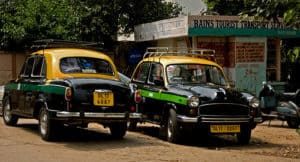Even as the online cab services are flourishing, making the demand for traditional cab drivers dwindle, they think it is too late to make a shift at this stage in their careers. But the modern cab drivers also experience their own share of problems
Cab services are doing booming business in Delhi, with every Uber and Ola driver having completed an average of 3,000 rides each, and Meru cabs catching up. Having said that, the traditional cabs also haven’t gone completely obsolete in Delhi. While the numbers and the demand is definitely dwindling, owners kali-pili (black-and-yellow) cabs are hanging on for nostalgic reasons. Riders generally tend to choose cab-hailing services over Ambassadors and Vans at taxi stands for a number of reasons – like the added perk of air conditioning, pick-ups from the doorstep, freedom to play music and charging points for phones. This makes for lousy business prospects for those who still drive the taxis of old.
Most of these drivers are still hanging on to what might be called archaic travel methods, simply out of a sense of nostalgia and attachment to the jobs they, or their fathers, held for decades. “Trying to make sense of the app is too much work for me. I don’t understand it!” laughs Santosh*, a driver of 10 years at the Green Park taxi stand. Another driver admits that the number of passengers they get now is growing smaller progressively, as are the number of black and yellow cabbies, and the market is being taken over by the popular cab services. But they are so used to waiting in the stands for passengers, and driving around the city without a GPS, to make a shift at this stage in their careers.

On the other hand, the drivers of Uber and Ola are experiencing extended working hours and a business that is better than the traditional cabs. Dheeraj* is a cabbie with over 4,500 rides under his belt, an almost perfect rating, and a proud father of two. Whilst checking his GPS navigation, he kept swiping back to his home screen, to a picture of his wife and daughters. “I like looking at it,” he said with a smile.
He begins talking about how he had driven enough people around to be able to tell by their accent that I wasn’t a Delhiite. Dheeraj is originally from Bihar, and moved to Delhi with his wife to make a better living and seek out better job opportunities. They moved here 13 years ago, and found a one-bedroom apartment in North Delhi, where the family of four lives. Humming along to retro Bollywood songs on the radio, he seems oddly satisfied for a man who makes about Rs. 15,000 a month and has to single-handedly support a family of four.
Every morning, he rides his bike to the garage where the cabs are parked, picks it up and starts his 12-hour work day from 6 am. “My family is my motivation,” explained Dheeraj, “I’m uneducated, so my employment opportunities are limited. It will be different for my daughters.” Both his daughters, 11 and 14 years old respectively, go to school regularly and thoroughly enjoy it. He even added that he has high hopes for his daughters since women are making a foray into all spheres, and the girls will not have to settle for a life they do not want.
His job isn’t exactly one with entertaining working hours, it tends to get rather monotonous driving across the city, sometimes up and down the same routes over and over. That since some riders, at the end of their own days, are less than cordial, it’s something Dheeraj has learned to take in his stride. A challenge he faces more and more these days is the increasing number of people opting for pool rides. Often the hours and the pay don’t add up, and despite spending hours in peak traffic, the fare ends up much lower than it should be.
He confides that even though the CNG is paid for by the company, a lot of gas, and time, is wasted in detours to pick up new passengers added to the pool share — something that the chauffeurs cannot reject without possible consequences. “While it is possible to redirect riders to other nearby drivers, it’s not something we prefer to do,” he says. Although he is entitled to only meagre pay, Dheeraj enjoys his job — the only real challenge he faced was learning how to operate the app, he tells us with a laugh. “I feel like I am investing in my future by educating my two daughters,” he says on a more serious note, before driving away with a quick wave and a “Thank you, Madam.”
As opposed to a driver who rents the vehicle he drives, a cabbie who does own his own vehicle stands to earn much more. After deducting maintenance and fuel cost. the driver would stand to make at least three or four times the amount a regular cab service driver would make. While most owners run their businesses by giving out their cars to cab services like Uber and Ola and paying the drivers a steady salary, some do drive their own cars. Some of the cab services allow part time work, and Sharma* opted for the same.
He is listed by his last name, instead of his first, which is usually the case. Asked why, he said that he’d always been addressed by his last name. Sharma is in his late fifties, and used to own a few yellow and black cabs back in the days when those were popular. He has three cabs on the roads, one of which he drives himself (part time). Why did he decide to start driving himself? “I was getting bored!” he laughed, “this keeps me busy, and I get to choose my hours. It’s a lucrative way for me to earn more by putting in a few extra hours.”
Clearly the lifestyles of those that own their cabs and those that don’t are quite different — primarily in their salaries and hours they work.
The growing demand for jobs in this area of public transport is quite surprising. This trend begs the question of how much longer Ambassador cabs will last, if at all.
*names changed on request





